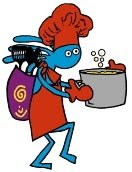• The first heart-shaped box of candy was sold in 1868 by Richard Cadbury. Chocolate has long been considered an aphrodisiac. The Aztec emperor Montezuma drank ground cocoa beans to increase his sexual prowess. In Mesoamerican marriage ceremonies, the couple shared a ritual cup of cocoa, which was believed to increase their luck in love.
• The red rose was thought to be the favorite flower of Venus, the Roman god of love and the father of Cupid. He is known as a mischievous, winged child, whose arrows would pierce the hearts of his victims causing them to fall deeply in love. He is prominently featured on boxes of chocolates created for Valentine’s Day.
The U.S. Greeting Card Association estimates that approximately one billion valentines are sent each year worldwide, making it the second largest card-sending holiday of the year, behind Christmas.
• The oldest known Valentine's Day card is on display at a London museum. This card was sent in 1415 by the Duke of Orleans to his wife in France. The Duke was imprisoned at the time in the Tower of London.
• Exchanging Valentine's cards most likely began in America as early as the 1700s. The first mass-produced Valentine's Day card was sold in the 1840s by Esther Howland, a Massachusetts native. She originally sold hand-made, lace cards for as much as $35 per card!
In Japan, the present custom that only the women give gifts to the men on Valentine’s Day was originated by a Japanese confectionary company. The traditional gift is chocolate, and is given by the woman to all of her male friends & acquaintances, including superiors and co-workers. There are two levels of gifts:
• Giri-choko (“obligatory chocolate”) is given by the woman as a token of friendship or gratitude to her male co-workers, superiors and friends. It isn’t unusual for a woman to buy and hand out one dozen or more boxes of chocolates on Valentine’s Day. It is thought that a man’s popularity can be measured by the number of chocolates that he receives on this day; however, this can be such a sensitive issue that some might not comment on it unless assured that it will not be made public.
It is expected for woman to give chocolates to their male co-workers. The unpopular co-workers will receive the chō-giri choko (“ultra-obligatory” or “cheap chocolate”).
• Honmei-choko (“favorite” or “true love chocolate”) is given by the woman to the man she loves, or is truly serious about. Usually, the “favorite chocolate” is given along with another gift such as a necktie.
One month later, on March 14th, the men are obligated (thus, the name “obligation chocolate”) to give gifts to all women who gave them chocolates on Valentine’s Day. March 14th is known as White Day – gifts include marshmallows or white chocolate, or candy in white boxes; the term refers to the color of marshmallows which was the type of candy originally marketed for this day. The recipients of giri-choko are expected to return a gift of at least equal value to each woman from whom they received chocolates.
(Sources: http://www.holidays.net/amore/didyouknow.htm, www.squidoo.com/valentine-traditions-worldwide, http://en.wikipedia.org/wiki/Valentine's_Day)
The recipe that we’ve chosen to share this month is for chocolate truffles and is delectable enough to qualify for a honmei-chocolate! The recipe is from the "Christmas in Colorado Cookbook". Permission to reprint the recipe has been granted by Golden West Publishers, Phoenix, AZ 85014.
CHOCOLATE TRUFFLES
NOTE: A candy thermometer is essential for this recipe.
Put cream and butter into saucepan. Let butter melt over medium heat then, stirring all the while, turn up heat and let the cream come just to a boil. Turn off the heat, add the semi-sweet chocolate and stir until it is completely melted. Continue stirring until the mixture thickens and cools somewhat. Divide mixture into separate bowls (depending on the number of different flavors you wish to make) and add liqueur, a tablespoon at a time, until desired flavor level is reached. Cover, place in refrigerator and allow to thicken overnight. Stir 3 or 4 times as it cools.
To form truffles, scoop up portions of the chocolate with a spoon. Dust lightly with cocoa and form into balls. Place balls on baking sheets and return to refrigerator immediately to recool.
Melt bittersweet chocolate with shortening in the proportions of 12 ounces of chocolate to 2 to tablespoons plus 2 teaspoons of shortening. Melt enough to dip all truffles.
Tempering: Heat mixture to 108 degrees, stirring constantly with a rubber spatula. When chocolate reaches 108 degrees, remove from heat. Stir until chocolate cools to 85 degrees. Continue stirring and scraping until mixture reaches 80 degrees. Keep mixture at this temperature, stirring constantly, for 10 minutes. This is important to develop crystals necessary for the glossy finish. Rewarm the chocolate to 86 degrees – hold there for 5 minutes before dipping. Keep chocolate at 86 degrees for the entire dipping process. Remove balls from refrigerator, allow to come to room temperature. Dip each ball in chocolate to coat. Place on wax paper or cookie sheet. Refrigerate again for 2 hours. Store in plastic containers, with wax papers between the layers to prevent sticking. Keep in a cool place.
YIELD: approximately 6 dozen.
NOTE: To identify the different flavors of truffles, put something on the top of each while still warm (i.e., an almond slice on the top of the Amaretto ones).
